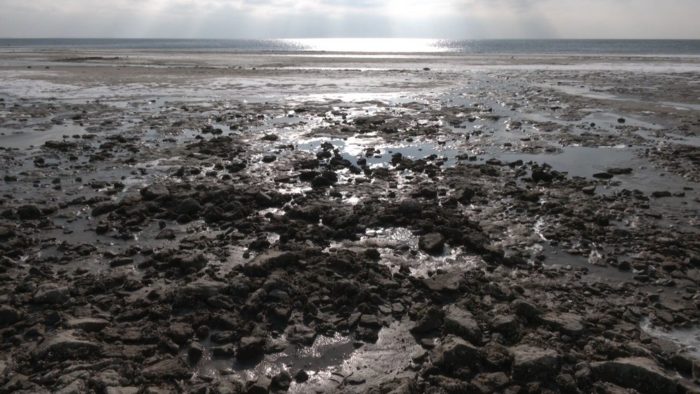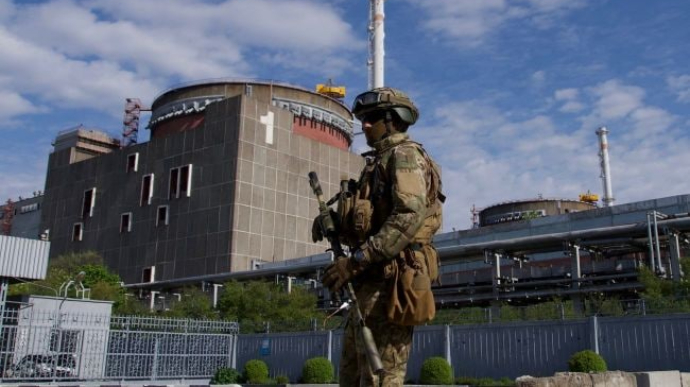
Credit: e-b.com.ua
In an exclusive interview with Euromaidan Press, Mykhailo Honchar explained how the Kakhovka dam could have been destroyed, what consequences such destruction could bring in the long run, and why this man-made disaster could be a harbinger of a Fukushima-like accident at Europe's largest nuclear power plant in Zaporizhzhia Oblast, southeastern Ukraine.
Euromaidan Press: The New York Times, in an article about the Kakhovka dam destruction, citing experts and engineers, suggested that an explosion from the inside destroyed the dam. What do you think about this?
Mykhailo Honchar: It was destroyed by an explosion from the inside. There is no doubt about it. The level of destruction that we see can be caused by a blast from the inside only. Furthermore, that explosion was extremely powerful, as magnetometers in Bucharest and Oslo registered a corresponding seismic wave.
Euromaidan Press: How much explosive should have been used to cause a blast of this magnitude and destroy the Kakhovka dam?
Mykhailo Honchar: It is hard to say, but I think that kind of magnitude probably involved dozens of tons of explosives.
Euromaidan Press: Is it possible to establish this fact without direct access to the dam?
Mykhailo Honchar: Of course, it is impossible. The dam was not destroyed by some anti-tank mine that weighs a few tens of kilograms. That is for sure.
We are talking about tons of explosives, tens of tons. One needs a lot of explosives to destroy a solid hydraulic structure like that.
Although some people say that the dam was old and had to be repaired, I can assure you that it was in good condition. This dam was originally designed to last for decades. It was supposed to hold billions of tons of water, and, accordingly, it contained millions of tons of reinforced concrete structures. It is an extremely solid reinforced concrete. Concrete, rebar, and stones.
We know that the entire dam was blown up together with a hydroelectric power plant, which was even more solid than the dam itself. While the dam was designed to hold static water pressure, the hydroelectric power plant had to deal with dynamic water movement and water pressure. Therefore, the hydroelectric plant's strength requirements and safety margins were even higher. Both the dam and the hydroelectric plant were extremely solid structures.
Therefore, any version claiming that the dam was destroyed by shelling from the Ukrainian side is untenable. There are no shells, even of the largest caliber (e.g., a shell of 203 mm), which can cause the level of destruction that we saw.

Euromaidan Press:
It is impossible to destroy this dam using the heavy artillery you mentioned, HIMARS rockets, missiles, or drones. Is that correct?
Mykhailo Honchar: It is absolutely impossible. If we consider air strikes, it will take several squadrons of bombers, such as Su-24s, that should drop high-explosive aircraft bombs for several hours, targeting this hydroelectric power plant to destroy it. However, even in this case, I doubt that such airstrikes could have caused the destruction we see now.
There is no doubt the explosion occurred from below. Obviously, the explosives were placed at the very bottom of the structure, in the turbine room of the Kakhovka hydroelectric power plant.
If the explosive had been placed at the top of the dam, it would have demolished several meters of the structure from above, not below. And, of course, there would be no such dynamic water flow as we observed.
Euromaidan Press: Is it true that this dam could withstand a nuclear strike?
Mykhailo Honchar: It depends on what kind of nuclear bomb we are talking about. As mentioned, the dam was designed with a large safety margin.
A nuclear explosive, even if we are talking about tactical nuclear weapons with a yield of several kilotons, is the equivalent of several thousand tons of ordinary TNT.
I doubt that the hydroelectric power plant could withstand a strike of this magnitude. A nuclear strike can be one of the few ways to destroy a hydroelectric power plant if we are talking about an explosion from the outside, not from below.
If we are talking about the dam destruction with conventional weapons used from above, then such a structure could be destroyed by airstrikes of bombers, which would have to bombard the object with precision for several hours in a row. Only then would the dam be destroyed by explosions from the outside. But again, there was no such degree of damage. Thus, only a blast from below could have caused the level of destruction we see now.
We can see that the authors behind the attack on the dam are not disguised. It is pretty obvious who planned and did that. If we assume that the dam was destroyed by the 205th Separate Motorized Rifle Brigade of the Russian Armed Forces [last autumn, the Telegram channel of the 205th Separate Motorized Rifle Brigade claimed that its troops mined the Kakhovka dam – ed.], which is commanded by the former Deputy Chief of the Academy of the General Staff of the Russian Armed Forces, then everything falls into place. He probably taught his students the Soviet art of war, according to which such a scenario as engineered flooding is acceptable to stop the enemy's advance.
Engineered flooding implies destroying a hydraulic structure to cause flooding or waterlogging the area to deter an enemy offensive. If such a structure is nearby and it is possible to destroy it to release the water flow and flood a specific area, this is considered appropriate, according to the Soviet or Russian art of war.
Euromaidan Press: How long will it take for the water to recede so Ukrainian troops can pass through those areas?
Mykhailo Honchar: It is hard to predict something like that now because the water is still moving in the lower reaches of the Dnipro River.
Even when this movement stops, the water will not recede completely.
Somewhere the water will go away, while in other areas, it will remain. Over time, some of the water will evaporate. It is hard to say how quickly it will happen. It will take at least a month for the water to recede and the area to dry.
Even if Russian troops left the waterlogged territory entirely, the Russians used mines as a part of their defensive lines in that area. The flood washed away some of those mines, and others exploded in the water flow. However, we have no idea how many mines are still there. That is, it is necessary to take some engineering measures to find out where all this stuff is today.
Euromaidan Press: While any offensive in that area is highly unlikely now, it is also unlikely that civilians will be able to live there any time soon. Is that correct?
Mykhailo Honchar: Absolutely. I do not know if anyone can live there after this flooding. For example, how can anyone live in a house that was flooded to the roof? In the city of Oleshky, for instance, many houses went down underwater. If such a house stays in the water for several days, I doubt it will be possible to live in it afterward. It is hard to say what condition it will be when the water recedes. Imagine what a house that stays underwater for a couple of days may look like. Everything inside will be ruined, and one must throw away the utensils, furniture, etc. It is hard to say how the house structure will behave in the future, how long it will take to dry out, and how damaged it will be.
Russia’s destruction of Kakhovka dam: five blows to economy, environment of world and Ukraine
Euromaidan Press:
Why did Russian troops bring explosives to the Kakhovka hydroelectric plant last year when a Ukrainian counteroffensive was not on the agenda?
Mykhailo Honchar: This suggests that the Russians already had a clear long-term plan. The explosion at the Kakhovka dam should not be viewed only in the context of this particular dam destruction. By destroying the Kakhovka dam, the Russians did not intend to take out of the dam only.
The Kakhovka dam destruction is part of a certain algorithm defined earlier. This algorithm has been activated now. It ultimately aims to create the preconditions for a Fukushima-type nuclear disaster at the Zaporizhzhia nuclear power plant (NPP).
The cooling system of the Zaporizhzhia NPP relied on the water from the Kakhovka reservoir. In fact, this NPP was built there because the reservoir had a sufficient volume of water to cool six nuclear reactors. In general, it was planned to build ten nuclear power units at Zaporizhzhia NPP, but Chornobyl nuclear disaster prevented those plans.
Thus, the Kakhovka dam destruction is the starting point of a far-reaching plan, in my opinion. Russian troops were waiting for the right time or a directive.
We must remember that Russian actions against Ukraine's hydraulic structures have already occurred. Let us not forget the Russian attempt to destroy the Karlivka dam in Kryvyi Rih. This dam was damaged by a Russian missile strike last year. Of course, the damage and consequences could not be compared to what we had after the Kakhovka dam was destroyed. The Karlivka dam is much smaller than the Kakhovka dam, which contained 18 cubic kilometers of water from the Kakhovka reservoir. Just imagine this parallelepiped, three by three kilometers at the base and two kilometers high.
What’s the worst that can happen at Zaporizhzhia nuclear power plant? Four scenarios
Euromaidan Press: What will happen to the Kakhovka water reservoir after the Kakhovka dam has ceased to exist?
Mykhailo Honchar: The reservoir will become shallow, and the water will drop to the level where the remnants of the destroyed dam are still present.
The water has already receded 30 meters from the shore in the Zaporizhzhia Oblast, north of the Kakhovka dam.
In some places of the Kakhovka reservoir, the depth reached 30 meters [before the Kakhovka dam destruction – ed.]. But in general, it has always been a relatively shallow reservoir. Its average depth does not exceed several meters. In recent years, due to global warming and the gradual shallowing of the Dnipro River, the water level in the Kakhovka reservoir has dropped slightly. This summer, we will see what will remain of the reservoir.
Euromaidan Press: Will a significant shallowing of the Kakhovka reservoir affect river-sea shipping?
Mykhailo Honchar: Absolutely. Shipping is no longer possible. The Kakhovka hydroelectric structure did not only serve as a hydroelectric power plant but also had locks. Through these locks, ships moved down the Dnipro River to the Black Sea and in the opposite direction, from south to north.

Credit: Suspilne Dnipro.
The intensive navigation on the Dnipro River started only when several reservoirs were built. These cascades of reservoirs and dams on the Dnipro River made it possible to navigate and transport multi-ton cargo via river to the sea and vice versa. Now shipping will not be possible until a new dam is built.
Euromaidan Press: How long will it take to build a new dam?
Mykhailo Honchar: From the point of view of modern technology, it is probably not as complicated an engineering task as it was 70 years ago when the Kakhovka hydroelectric power plant was built. Undoubtedly, it will cost a lot of money.
Euromaidan Press: You mentioned that blowing up the Kakhovka dam could be part of a larger plan to destroy or damage the Zaporizhzhia nuclear power plant. Do you think this plan has already been launched?
Mykhailo Honchar:
Yes, in my opinion, this plan has been launched. The destruction of the Kakhovka dam is the starting point. In fact, this plan envisages the use of nuclear weapons against Ukraine without using nuclear warheads.
If a nuclear reactor is depressurized, as happened in Fukushima, a nuclear disaster will follow. Such a nuclear disaster will be equivalent to the use of tactical nuclear weapons. This is what Russia has constantly threatened.
I think that this plan was developed by Sergei Kiriyenko [First Deputy Chief of Staff of the Presidential Administration of Russia – ed.]. Kiriyenko had been the head of Rosatom [a Russian state-owned corporation specializing in nuclear energy - ed.] for 11 years. He knows the specifics of nuclear technology.
Perhaps, Kiriyenko actively developed a hybrid algorithm that should bring the situation to a high-level nuclear accident. An accident at the Zaporizhzhia NPP would be equivalent to using nukes. By creating the basis for a nuclear accident like that, the Russians can threaten Ukraine and Europe with the consequences. Russia is already playing this card.
Russians install explosive-like objects on the roof of Zaporizhzhia NPP to imitate Ukrainian strikes
Euromaidan Press: Will Russian threats come to the point where Russia actually damages the nuclear reactor?
Mykhailo Honchar: A year ago, there were hopes that the Russians would not blow up the Kakhovka hydroelectric power plant when they brought explosives down there. This hydropower plant fed the Crimean Canal, which supplied water to the Russian-occupied Crimean Peninsula. Where is logic? The usual reasoning does not work when we analyze Russia's actions. On the contrary, we should assume that since the Russians have created such a plan and the algorithm of measures has already been launched, they are ready for this.
We do not know how it will turn out and whether the Russians will feel the need to implement this plan to the end. I believe the Russian leadership will decide depending on the situation as it unfolds.
Euromaidan Press: The decline in the water level in the Kakhovka reservoir should affect the safe operation of the Zaporizhzhia NPP. That is, cooling nuclear reactors at the plant may become difficult. Will it be possible at all?
Mykhailo Honchar: This definitely puts the nuclear power plant in danger. Now, while the water has not completely receded, there will be no immediate threat to the safe operation of the plant in the coming days or weeks. But we do not know how much water will be left in there. After all, there is a critical water level for the safe operation of the plant. When the water gets below this critical level, it will not flow from the reservoir to the cooling system of nuclear reactors at the Zaporizhzhia NPP.
https://twitter.com/EuromaidanPress/status/1669057365985902594
Currently, five reactors out of six are shut down. They are in a cold state. One reactor is in a hot condition. But even a cold reactor needs to be cooled because the reaction continues in there; heat is being released, and the reactor needs to be cooled.
For example, the accident at the Fukushima nuclear power plant occurred because the water supply to the cooling system of the reactors, which were shut down, accidentally stopped. The temperature inside the reactors kept rising, the core actively melted, and an explosion occurred, triggering a radioactive leak.
Euromaidan Press: The Kakhovka dam destruction may eventually lead to the damage of all six nuclear reactors at the Zaporizhzhia NPP, right?
Mykhailo Honchar: I am not sure about all six reactors, but at least one reactor is at risk. The fact that Russia, which occupies the Zaporizhzhia NPP, still keeps one reactor in a hot state may indicate that they have a nuclear accident scenario up their sleeve. The explosion of one reactor would be enough for a nuclear disaster.
Related:
- Russian troops blow up Kakhovka dam, unleashing environmental disaster
- No, the Kakhovka dam could not have collapsed on its own
- Seismic signals indicate Kakhovka dam explosion - NORSAR
- Ukraine begins construction of 150-km pipeline to restore water supply following Russia's destruction of the Kakhovka dam
- Russia plotting "terrorist attack" with radiation release at Zaporizhzhia nuclear plant - Zelenskyy
- Russians reduce their presence at Zaporizhzhia nuclear plant - Ukraine intel
- Russian troops plant explosives near 4 nuclear reactors at Zaporizhzhia NPP - Ukraine's intel

